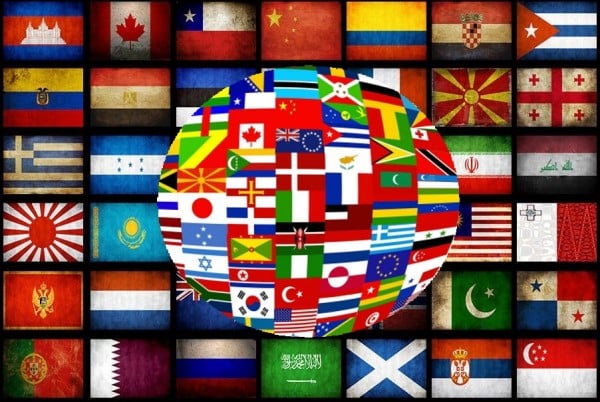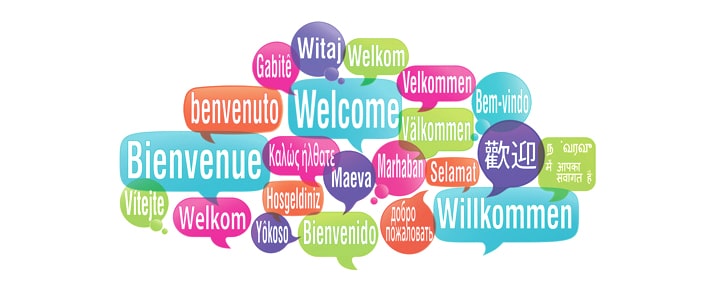10 WordPress Multilingual Plugins for Translation
- Saudi ERP & Website Solution Blog September 14,2023

WordPress multilingual plugins for website translation. These days, everyone building website for business purposes. WordPress website is more SEO and user friendly. WordPress uses widely all over the world.
People develop their website in the WordPress open source Content Management Systems. By default WordPress not offering a multilingual service for local develop websites.
But there are many plugins who are providing services to convert your website into different languages. But some of plugin is outdated and some of plugin not working well.
But after my search, I am going to share my research about best WordPress multilingual plugin this plugin have a good rating and review as well. there are 10 plugins which are good to use for website translation.
1. WooCommerce Multilingual – run WooCommerce with WPML
- Lets you multilingual different kinds of Woo Commerce product types
- Central management for translating product categories, tags and custom attributes
- Automatically synchronizes product variations and images
- Keeps the same language through the checkout process
- Sends emails to clients and admins in their selected language
- Allows inventory tracking without breaking products into languages
- Enables running a single Woo Commerce store with multiple currencies
- Upload ‘woo commerce-multilingual’ to the ‘/wp-content/plugins/’ directory
- Activate the plugin through the ‘Plugins’ menu in WordPress
- Translate the shop pages
2. WPGlobus – Multilingual Everything!
- Provides admin interface to translate posts, pages, menus, widgets, categories and tags to multiple languages.
- Adds a drop-down menu to a navigation menu, thus allowing to switch between languages, by changing the URL (/{language}/page/)
- The administrator interface allows for selecting active languages as well as defining custom combinations of country flag and language abbreviation.
- You can install this plugin directly from your WordPress dashboard:
- Go to the Plugins menu and click Add New.
- Search for WPGlobus.
- Click Install Now next to the WPGlobus plugin.
- Activate the plugin.
- Alternatively, see the guide to Manually Installing Plugins.
3. Polylang
- You can use as many languages as you want. RTL language scripts are supported. WordPress multilingual plugin languages files are automatically downloaded and updated.
- You can translate posts, pages, media, categories, post tags, menus, widgets… Custom post types, custom taxonomies, sticky posts and post formats, RSS feeds and all default WordPress widgets are supported.
- The language is either set by the content or by the language code in url (either directory or subdomain), or you can use one different domain per language
- Categories, post tags as well as some other metas are automatically copied when adding a new post or page translation
- A customizable language switcher is provided as a widget or in the nav menu
- The admin interface is of course multilingual too and each user can set the WordPress admin language in its profile
- Make sure you are using WordPress 3.5 or later and that your server is running PHP 5.2.4 or later (same requirement as WordPress itself)
- If you tried other WordPress multilingual plugin, deactivate them before activating Polylang, otherwise, you may get unexpected results !
- Download the plugin
- Extract all the files.
- Upload everything (keeping the directory structure) to the /wp-content/plugins/ directory.
- Activate the plugin through the ‘Plugins’ menu in WordPress.
- Go to the languages settings page and create the languages you need
- Add the ‘language switcher’ widget to let your visitors switch the language.
- Take care that your theme must come with the corresponding .mo files (Polylang downloads them for themes and plugins bundled with WordPress). If your theme is not internationalized yet, please refer to the codex or ask the theme author to internationalize it.
4. qTranslate X
- One-click local switching between the languages – Changing the language as easy as switching between Visual and HTML.
- Language customizations without changing the .mo files – It stores all the translations in the same post fields, while shows it to user for editing one by one depending on the language to edit chosen.
- In-line syntax ‘<!–:en–>English Text<!–:–><!–:de–>Deutsch<!–:–>’ or ‘[:en]English Text[:de]Deutsch’ for theme-custom fields gets them translated. See FAQ for more information.
- Multilingual dates out of the box – Translates dates and time for you.
- Theme custom fields can be configured to be translatable too.
- Comes with a number of languages already built-in – English, German, Simplified Chinese, for example, and many more.
- Download the plugin from here.
- Extract all the files.
- Upload everything (keeping the directory structure) to the /wp-content/plugins/ directory.
- Deactivate plugin qTranslate, mqTranslate, qTranslate Plus, or zTranslate, if you are running any.
- Activate qTranslate-X through the ‘Plugins’ configuration page in WordPress.
- Open Settings->Languages configuration page and add/delete/disable any languages you need.
- Add the “qTranslate Language Chooser” widget or “Language Switcher” menu item to let your visitors switch the language.
- You may use Google XML Sitemaps v3 for qTranslate plugin to rebuild your XML sitemap for better SEO support.
- Configure theme custom fields to be translatable if needed (Settings -> Languages: “Custom Fields”).
- Upgrading from qTranslate required no additional actions, qTranslate-X will continue to work from the database entries of qTranslate. One may also go back to qTranslate at any time. Upgrading from other qTranslate forks may require re-configuration of the languages and taxonomies names, unless you rename corresponding database entries directly.
5. WordPress Multilingual Plugin (WPML)
- Variant languages compatibility: Allows users to add their own language even if it is a variant of another language.
- Powerful translation management: Manages the translation by itself without creating any addition interference from the users.
- Multilingual CMS: It works well with Multilingual Content Management System sites powered by WordPress.
- Theme and plugin text translation: The text of a theme or plugin is available in English but this plugin can translate these texts in other languages known to it. This helps the people of other languages to make use of the plugin in their own sites or blogs.
- Translation of comments from the visitors: It automatically translates the comments of the visitors or subscribers in the preferred languages. Both site owners and other viewers can get the benefits of this facility by and large.
6. Yet Another Related Posts Plugin (YARPP)
- Enable YARPP Pro for Powerful Enhancements
- Customize thumbnail layout through the user interface.
- Pull related content from multiple sites.
- Make money by displaying sponsored content, at the bottom of your posts, in the sidebar, or both.
- Easily promote your product or service on thousands of blogs and websites.
- Get detailed reporting about your related content list.
- Auto display on your website
- Copy the folder yet-another-related-posts-plugin into the directory wp-content/plugins/ and activate the plugin.
- (optionally) copy the sample template files inside the yarpp-templates folder into your active theme.
- Go to the “Related Posts (YARPP)” settings page to customize YARPP.
7. Transposh WordPress Translation
- Support for any language – including RTL/LTR layouts
- Unique drag/drop interface for choosing viewable/translatable languages
- Multiple options for widget appearances – with pluggable widgets and multiple instances
- Translation of external plugins without a need for .po/.mo files
- Automatic translation mode for all content (including comments!)
- Professional translation bt One Hour Translation
- Use either Google Translate,MS Translate or Apertium backends – 92 languages supported!
- Automatic translation can be triggered on demand by the readers or on the server side
- RSS feeds are translated too
- Takes care of hidden elements, link tags, meta contents and titles
- Translated languages are searchable
- Buddypress integration
- Upload the plugin to the /wp-content/plugins/ directory
- Activate the plugin through the ‘Plugins’ menu in WordPress
- Add the widget to your side bar, decide which interface you prefer
- On the settings page – define which languages you would like viewable, translatable and which language is currently used (default) by clicking and dragging
- You may also elect to disable/enable the automatic translation mode
- You are good to go
8. Zanto WP Translation (For Multisites)
- Translation of posts, categories, custom taxonomies, custom types.
- Browser Language re-direct i.e re-direct users to their preferred language in their browser language settings.
- An easily customizable language switcher.
- Ability to use custom made Language switcher themes.
- Add a language parameter to the URL for SEO purposes
- Ability to create multiple translation networks within the same multisite. i.e blog A is a translation of Blog B and C. Blog X a translation of blog Z, while all blogs are in the same multisite.
- Different languages for both the front and back end.
- Each admin will have his admin language preferences stored
- Over 60 in-built languages and flags.
- Ability for users to add their own native languages i.e from the ones not included.
- Integrated support for domain mapping plugin
- multilingual posts highlighting to prevent double translation
- Copy posts data from one blog to the translation area
- A translation editor to multilingual all posts from one blog to all others without switching between blogs. (Additional Translation Manager plugin required)
- Create and Manage translators from a single blog. Translators have their own dashboard. (Additional Translation Manager plugin required)
- Assign Translations to individual translators.(Additional Translation Manager plugin required)
- Export and Import XLIFF translations for posts taxonomies, comments, custom fields. (Additional Translation Manager plugin required)
9. Multilanguage
- You can use as many languages as you want. By default, you can choose one of 76 pre-installed languages. However, you can add any number of languages to list of pre-installed languages in “include/languages.php” file.
- You can add translations for posts, pages, categories, and post tags.
- The language is either set by the language switcher or by the language code in url (as directory).
- A customizable language switcher is provided as a widget, which can be displayed in the form of a Drop-down list of languages, Drop-down list of flags icons or Flags icons.
- You can determine the priority of language display in the switcher by changing the priority of language display on the plugin settings page.
- The admin interface is translation-ready
- Upload the multilanguage folder to the /wp-content/plugins/ directory.
- Activate the plugin using the ‘Plugins’ menu in your WordPress admin panel.
- You can adjust the necessary settings using your WordPress admin panel in “BWS Plugins” > “Multilanguage”.
- Plugin page is located in main menu.
10. Theme Blvd WPML Bridge
- Compatible Themes
- String Translation
- WPML Bridge Plugin
- Theme Options
- Custom Homepage Layouts
- Page Templates and Options
- Custom Layouts & Static Pages
- WPML Breadcrumbs
- Widgets and Widget Areas
- Frontend Language Switchers
- Upload theme-blvd-wpml-bridge folder to the /wp-content/plugins/ directory
- Activate the plugin through the ‘Plugins’ menu in WordPress
Keep in touch....For more informative posts!










 Saudi Arabia (English)
Saudi Arabia (English) United Kingdom
United Kingdom Global Site
Global Site